38 Results

Students will discover contributions of Black inventors and pioneers in the field of energy efficiency and the assets they possessed that helped them overcome challenges. ABOUT THIS WEBQUEST: Built around the themes of Black Leaders in Energy, Representation, & Climate Change 5E lesson format: Engage, Explore, Explain, Elaborate, EvaluateEach “E” can be used as an independent lesson or all five can be completed as a unit (Each “E” takes 1-2 class periods to complete)Requires collaboration/discussion with peers and as a whole classCan be embedded in Energy or Climate curriculum or used as stand-alone lesson/sCan be modified to meet the needs of your students Recommended for grades 7-12This lesson requires use of the internet.Use this slideshow with the Black Leaders in Energy Webquest Activity Sheet.If students are utilizing a digital copy of the activity sheet, all links provided are active.If students are utilizing a paper copy of the activity sheet, please share a copy of the slideshow with them so they have easy access to links needed for the webquest.Remix this resource to have a version you can edit to meet your needs.This resource was developed by KEEP—Wisconsin's K-12 Energy Education Program.
- Subject:
- Environmental Literacy and Sustainability
- Material Type:
- Activity/Lab
- Learning Task
- Lesson
- Author:
- Victoria Rydberg-Nania
- Gina Smith
- Date Added:
- 05/08/2023
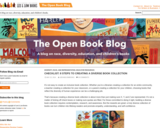
It’s not easy to create an inclusive book collection. That’s because creating a diverse book collection is about more than just making sure X, Y, and Z are represented. It’s not a matter of ticking off check boxes or making sure quotas are filled. For those committed to doing it right, building a diverse book collection requires contemplation, research, and awareness. But the rewards are great: a truly diverse collection of books can turn children into lifelong readers and promote empathy, understanding, and self-confidence. To make things a little easier, we’ve created a checklist to help.
- Subject:
- Library and Information Science
- Material Type:
- Self Assessment
- Teaching/Learning Strategy
- Author:
- Lee and Low Books
- Date Added:
- 05/23/2022
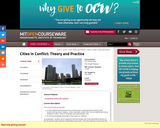
This course's aims are two-fold: 1) to offer students the theoretical and practical tools to understand how and why cities become torn by ethnic, religious, racial, nationalist, and/or other forms of identity that end up leading to conflict, violence, inequality, and social injustice; and 2) to use this knowledge and insight in the search for solutions. As preparation, students will be required to become familiar with social and political theories of the city and the nation and their relationship to each other. They also will focus on the ways that racial, ethnic, religious, nationalist or other identities grow and manifest themselves in cities or other territorial levels of determination (including the regional or transnational). In the search for remedies, students will be encouraged to consider a variety of policymaking or design points of entry, ranging from the political- institutional (e.g. forms of democratic participation and citizenship) to spatial, infrastructural, and technological interventions.
- Subject:
- Art and Design
- Fine Arts
- Material Type:
- Full Course
- Provider:
- M.I.T.
- Provider Set:
- M.I.T. OpenCourseWare
- Author:
- Davis, Diane E.
- Date Added:
- 01/01/2003
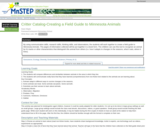
This activity will help students learn about Minnesota animals and characteristics that distinguish them from one another.
- Subject:
- Life Science
- Zoology
- Material Type:
- Activity/Lab
- Lesson Plan
- Provider:
- Science Education Resource Center (SERC) at Carleton College
- Provider Set:
- Pedagogy in Action
- Date Added:
- 02/10/2023
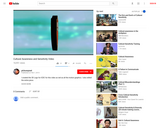
This video discusses the need for cultural awareness and ways to exhibit cultural sensitivity.
- Subject:
- Business and Information Technology
- Career and Technical Education
- Material Type:
- Other
- Author:
- ICDC College
- Date Added:
- 06/01/2018

In this unit, students make regular journal entries about a plant/animal/insect community in the natural area around our school and use this to create a Non-fiction Class Book. They also interview family/resources to discover, record and present stories about human relationships with nature from their culture(s).
- Subject:
- Biology
- Life Science
- Material Type:
- Activity/Lab
- Provider:
- Science Education Resource Center (SERC) at Carleton College
- Provider Set:
- Pedagogy in Action
- Author:
- Natasha Rubenstein
- Date Added:
- 02/10/2023
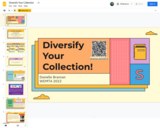
Slide deck from WEMTA 2022 presentation on how to create a diverse collection, including lots of links to additional resources and an example audit.
- Subject:
- Library and Information Science
- Material Type:
- Lecture Notes
- Author:
- Danielle Brannan
- Date Added:
- 05/16/2022
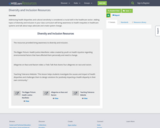
Addressing health disparities and cultural sensitivity is considered a crucial skill in the healthcare sector. Adding topics of diversity and inclusion in your class curriculum will bring awareness to health inequities in healthcare systems and talk about ways advocate and create system change.
- Subject:
- Health Education
- Health Science
- Material Type:
- Activity/Lab
- Author:
- Caitlyn Mowatt
- Date Added:
- 02/01/2021

This is a blog from St. George's University that provides infographics explaining the benefits of diversity in the healthcare workplace, and why it should be encouraged. An activity I'd like you to do with your students is to have to have them read the whole article and then form small groups of 2 to 3 people. After forming groups, have each student share 1 way that diversity benefits patients, and 1 way diversity benefits health providers. The takeaway should be that diversity is very important in the healthcare space and it promotes better quality of care.
- Subject:
- Career and Technical Education
- Health Science
- Material Type:
- Reading
- Author:
- St. George's University
- Date Added:
- 07/21/2022
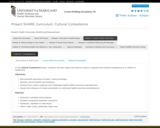
This website provides an icebreaker, presentation/video, and classroom research/discussion activity to teach students about diverse beliefs that impact medical care delivery. The resource provides a lesson plan for teachers which includes learning objectives, lesson format, vocabulary, and materials needed. Through the optional icebreaker, students can reflect on their identities and learn about diversity in the classroom. Through the Cultural Competence presentation and video, students can learn about diversity and culture in general. And through the research/discussion activity, students can understand a certain culture/country and their beliefs on medical care. They can share their findings with a small group and answer some provided discussion questions. Not only does this activity teach students that diversity can impact beliefs and behaviors about medicine, but it also teaches respect for other cultures AND it teaches what specific countries/cultures believe about medicine.
- Subject:
- Career and Technical Education
- Health Science
- Material Type:
- Activity/Lab
- Interactive
- Learning Task
- Lecture
- Lecture Notes
- Lesson
- Lesson Plan
- Teaching/Learning Strategy
- Date Added:
- 07/20/2022
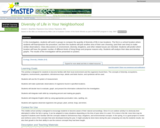
This is a field investigation on diversity of life where students count the number of kinds organisms in two locations. Students report their results on posters and propose reasons why there might be difference in diversity between the locations.
- Subject:
- Biology
- Life Science
- Material Type:
- Activity/Lab
- Provider:
- Science Education Resource Center (SERC) at Carleton College
- Provider Set:
- Pedagogy in Action
- Author:
- Daniel C. Bearfield
- Date Added:
- 02/10/2023
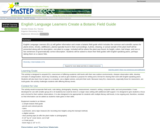
ELL students create and share a botanic field guide incorporating depiction, measurement, description, and classification of common Minnesota trees, shrubs, wildflowers, and plants.
- Subject:
- Botany
- Education
- Language Education (ESL)
- Life Science
- Material Type:
- Activity/Lab
- Data Set
- Provider:
- Science Education Resource Center (SERC) at Carleton College
- Provider Set:
- Pedagogy in Action
- Author:
- Nenette Onstad
- Date Added:
- 02/10/2023
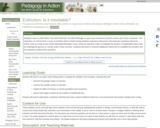
Students read an article titled "The Sixth Extinction" by Niles Eldredge on past mass extinctions and the current rate of loss of species. The instructor can choose from a suite of activities which include having students respond to discussion and extension questions about the article, write an essay on the article defending Eldredge's view, create an extinction chart, and debate the actions of stakeholders faced with an endangered species vs. human water needs scenario. Students will need to research additional references to complete the activities and be prepared to defend their positions.
- Subject:
- Ecology
- Life Science
- Material Type:
- Activity/Lab
- Provider:
- Science Education Resource Center (SERC) at Carleton College
- Provider Set:
- Pedagogy in Action
- Author:
- Susan Musante
- Date Added:
- 02/10/2023
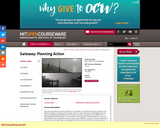
This course introduces incoming students in the Master in City Planning (MCP) program to the theory and history of planning in the public interest. It relies primarily on challenging real-world cases to highlight persistent dilemmas, the power and limits of planning, the multiple roles in which planners find themselves in communities around the globe, and the political, ethical, and practical dilemmas that planners face as they try to be effective. As such, the course provides an introduction to the major ideas and debates that define what the field labels ŰĎplanning theory,Ű as well as a (necessarily) condensed global history of modern planning. Courses in planning history, politics, and ethics--often several of them--are required in all accredited graduate programs in planning in the U.S. Gateway: Planning Action combines those contents, with a stronger focus on real-world cases than more conventional lecture-based planning theory and history courses at other schools. It also adds several opportunities to strengthen hands-on professional competencies, especially in communication.
- Subject:
- Social Studies
- U.S. History
- Material Type:
- Full Course
- Provider:
- M.I.T.
- Provider Set:
- M.I.T. OpenCourseWare
- Author:
- de Souza Briggs, Xavier
- Date Added:
- 01/01/2007
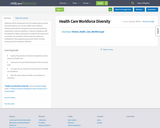
Students will be introduced to the US health system and the lack of diversity in our current health care workforce. Students will explore how patient outcomes are positively impacted by a diverse workforce. Cultural Competence will be explored in depth. Approaches to improve the diversity of our health care workforce will be explored. Videos are embedded in this prepared power point which includes various points for students reflection.
- Subject:
- Career and Technical Education
- Health Science
- Material Type:
- Activity/Lab
- Date Added:
- 06/21/2019
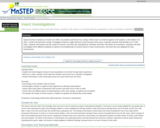
This activity is a field investigation or bio-blitz where students are collecting as many different types of insects as they can. Back in the lab, they will record their findings, sort and classify the insects found. This will lead into a class discussion on biodiversity and the importance of insects and their benefits all living things.
- Subject:
- Biology
- Life Science
- Material Type:
- Activity/Lab
- Provider:
- Science Education Resource Center (SERC) at Carleton College
- Provider Set:
- Pedagogy in Action
- Author:
- Jaime Souza
- Date Added:
- 02/10/2023

This OER textbook is adapted from Social Problems: Continuity and Change under a Creative Commons Attribution-NonCommercial-ShareAlike license. The original author asked not to receive attribution. It covers poverty, racial and ethnic inequality, sexual orientation and inequality, aging and ageism, and religion.
- Subject:
- Ethnic Studies
- Social Studies
- Material Type:
- Textbook
- Author:
- Northeast Wisconsin Technical College
- Date Added:
- 11/18/2021

In this field lab students will investigate the biodiversity around their school. Students will perform a biodiversity count using transect line. The students will develop multiple hypotheses relating to biodiversity and propose additional procedures for studying, collecting and testing these questions.
- Subject:
- Ecology
- Life Science
- Material Type:
- Activity/Lab
- Provider:
- Science Education Resource Center (SERC) at Carleton College
- Provider Set:
- Pedagogy in Action
- Author:
- Todd Koenig
- Date Added:
- 02/10/2023
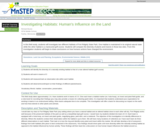
This investigation is a field study where students compare the diversity of plants and insects in a naturally existing habitat to that of a human altered habitat.
- Subject:
- Ecology
- Life Science
- Material Type:
- Activity/Lab
- Provider:
- Science Education Resource Center (SERC) at Carleton College
- Provider Set:
- Pedagogy in Action
- Author:
- Richard Busse
- Date Added:
- 02/10/2023
